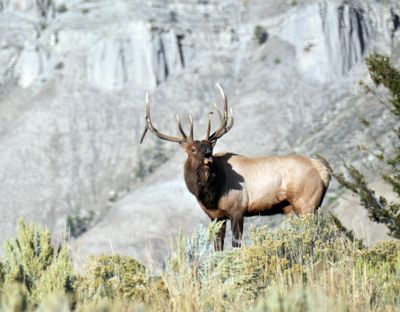Montana rejects plan to haze elk to prevent disease spread

HELENA – Montana’s Fish and Wildlife Commission on Thursday shot down a proposal to separate elk presumed to be exposed to disease from unexposed elk herds, an idea that wildlife officials acknowledged probably wouldn’t work even as they pitched it.
The hazing plan, backed by the livestock industry, was meant to keep small groups of elk that are within a designated brucellosis surveillance area north and west of Yellowstone National Park from coming into contact with other groups from outside the area. It was proposed as an addition to a larger management plan to prevent the spread of brucellosis, a disease that causes animals to abort their young, and its transmission from wildlife to livestock.
The commission unanimously panned the hazing plan, saying the focus should stay on keeping disease-exposed elk away from cattle. It would be impossible to haze elk away from other elk across southwestern Montana’s wide landscapes, and ensure the animals stay separated day and night, commissioners said.
“To me, this is way too much like animal husbandry and not like managing wild, free-ranging wildlife,” Commissioner Gary Wolfe said.
The management plan already allows elk-kill permits, fencing and the hazing of elk away from cattle in the designated surveillance area where brucellosis-positive elk live.
The surveillance area stretches east from Beaverhead County to Park County and south from Interstate 90 to Yellowstone and the Wyoming border. FWP officials said the elk-hazing program would be in response to known, small groups of disease-exposed elk encroaching upon disease-free elk near that boundary. The aim would be to prevent the surveillance area’s boundaries from expanding as new elk groups come into contact with exposed elk.
“We understand it’s different, new, an additional layer of difficulty,” said Quentin Kujala, the FWP’s wildlife management section chief. “But we see a responsibility to flesh the issue out.”
Of particular concern is a herd of elk from Wyoming that has been ranging close to a Montana herd outside of the surveillance area along the eastern front of the Beartooth Mountains, said Montana state veterinarian Marty Zaluski.
“Once these elk mix, whether it is 12 or 24 months, we’ll have no opportunity to unscramble the eggs,” Zaluski said.
Zaluski acknowledged the hazing plan’s shortcomings, and suggested instead the wildlife agency come up with a strategic elk-hunting plan for that area that would have the desired effect of keeping the herds separate.
Department officials said they will examine hunting options. Fish and Wildlife Commission Chairman Dan Vermillion also called on Wyoming to end its practice of putting out grass and alfalfa hay in feedgrounds to help elk survive the winter.
The clusters of elk at feedgrounds have been blamed for promoting the spread of diseases such as brucellosis and chronic wasting disease.
“It’s not Montana’s place to tell Wyoming what to do,” Vermillion said, and added that closing the feeding grounds wouldn’t end the problem overnight.
“But it would be a good start on that path,” he said.